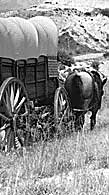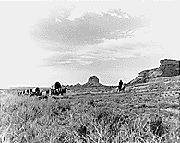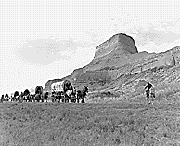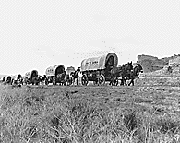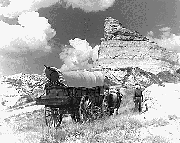 |
||
  |
||
|
|
On the Oregon TrailIntroductionIn this lesson, students work with primary documents and latter-day photographs to recapture the experience of traveling on the Oregon Trail. Learning Objectives(1) To learn about the pioneer experience on the Oregon Trail. (2) To evaluate a historical re-enactment in light of documentary evidence. (3) To synthesize historical data through creative writing.Guiding Question:What was it like to travel West on the Oregon Trail?1 Begin by asking students to imagine that they are producing a movie on the Oregon Trail. Working in groups, they will write a scene for the movie that is historically accurate and based on the kinds of experiences emigrants actually encountered on their way West. For background on these experiences, have students read a selection of the following memoirs, available through EDSITEment Websites:
2 As a follow up to their reading, give each group a set of pictures showing a reenactment of the trek West on the Oregon Trail. The pictures below are available through EDSITEment at The Digital Classroom website. (Click picture for larger image.)
3 Ask students to examine the pictures in light of their reading. For additional insight, have students visit The Oregon Trail website on EDSITEment, focusing on the pages listed below. (You can also provide print-outs of these pages in classrooms with limited Internet access.)
4 Invite students to comment on this reenactment in their
role as imaginary filmmakers. How does it compare to the scene they have in mind?
Have each group suggest additional details that would accurately represent the
emigrants' historical experience. Students might note, for example:
5 Encourage students to make imaginative use of this research as they work together in their groups to script a scene depicting an incident that could have occurred on the Oregon Trail. To provide them with a framework for their collaboration, create a worksheet based on the outline headings below. (For more technical filmscripting guidelines, visit the Cinema exhibit at the Learner.Org website on EDSITEment.)
6 Conclude the lesson by having each group "pitch" its scene to the class, as at a Hollywood production meeting. This could involve preparing storyboards for the scene's establishing shots and acting out parts of the action. Follow each presentation with a class critique of the scene's historical accuracy focusing both on elements that reflect the real experience of pioneers on the Oregon Trail and elements that take liberties with the historical record. Extending the Lesson
Standards Alignment View your state’s standards |
|||||||||||||||||||||||||||||||||||||||||||||||||||||||||||||
  |
||
| EDSITEment contains a variety of links to other websites and references to resources available through government, nonprofit, and commercial entities. These links and references are provided solely for informational purposes and the convenience of the user. Their inclusion does not constitute an endorsement. For more information, please click the Disclaimer icon. | ||
| Disclaimer | Conditions of Use | Privacy Policy Search
| Site
Map | Contact
Us | ||
